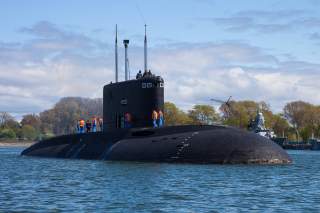U.S. Navy Beware! Russian Submarines Surge Into the Atlantic
The Russian navy in mid-October 2019 sortied eight submarines in the country’s biggest undersea exercise since the Cold War.
The Russian navy in mid-October 2019 sortied eight submarines in the country’s biggest undersea exercise since the Cold War.
The eight submarines, including six nuclear-powered ships, sailed from their bases in northern Russia into the cold waters of the Barents and Norwegian Seas. At the same time, an additional two boats -- the nuclear-powered Sierra-class attack submarines Pskov and Nizhny Novgorod -- sailed into roughly the same waters for tests and training.
The 10 vessels represent around 20 percent of the Russian submarine force. For comparison, the U.S. Pacific Fleet with its roughly 30 subs as recently as 2013 reliably could deploy eight boats on short notice. The U.S. fleet in total operates more than 50 submarines split between the Pacific and Atlantic Fleets. This number is shrinking.
The eight vessels in the planned, 60-day Russian exercise are practicing protecting a “bastion” of open ocean in which Russian ballistic-missile submarines can hide. “The aim of the massive operation is to get as far out to the North Atlantic as possible without being discovered by NATO,” Barents Observer noted, citing Norwegian intelligence sources speaking to news outlet NRK.
The Russian exercise seems to underscore Moscow’s new approach to undersea warfare. While the current war game reportedly is defensive in nature, the same submarines could conduct offensive operations from the same waters.
During the Cold War, Soviet submarines needed to pass through the maritime chokepoint between Greenland, Iceland and the United Kingdom -- the so-called “GIUK Gap” -- in order to reach the open ocean and close within striking range of NATO ports and ships. That’s not the case with newer Russian subs with their longer-range weapons.
“Russian submarines no longer have to transit the gap to have a dramatic impact on the European military balance,” Andrew Metrick, an analyst with the Center for Strategic and International Studies in Washington, D.C., explained in Proceedings, the professional journal of the U.S. Naval Institute. “Rather, they can operate from the relative safety of bastions in the Norwegian and Barents seas and strike targets across Northern and Central Europe.”
In attempting to counter the Russian subs, the United States and NATO should avoid slipping back into its own Cold War ways, experts warned. They said it takes creative thinking to understand, and counter, Russia's current undersea-warfare doctrine.
A response centered on the GIUK Gap “risks misprioritizing future investments,” Metrick wrote.
Assuming budgets remain at their current level, in the 2020s the Russian submarine fleet could include up to 10 Yasen-class guided-missile submarines plus upgraded Kilo-, Akula-, Oscar- and Sierra-class attack submarines, for a grand total of probably around 50 vessels.
Many of the boats will carry the Russian navy’s new Kalibr land-attack cruise missile, which apparently can strike targets as far away as 1,500 miles. Kalibr “gives the Russian navy a long-range strike capability it has never before possessed,” Metrick wrote.
A Yasen-class submarine could fire its 40 Kalibrs from the Russian side of the GIUK Gap and still strike strategic NATO ports in western Europe such as Bremerhaven. “This new reality cannot be addressed by focusing on the GIUK Gap,” Metrick warned.
"To respond adequately, the United States and NATO must move beyond the outdated barrier-defense concept and fully embrace open-ocean [anti-submarine warfare], with far greater emphasis on operating in contested waters well north of the Arctic Circle," Metrick advised. "Instead of static ASW barriers, the United States and NATO must shift to a model of mobile ASW nets that can be rapidly constituted and focused on likely areas of operation."
"This will require developing a new generation of ASW capabilities," Metrick pointed out. "Chief among potential systems are large unmanned underwater vehicles with considerable on-station time to provide initial cueing for other ASW assets."
A new Russian submarine threat requires new NATO defenses. But the Western alliance should not despair, Metrick wrote.
“By unshackling themselves from past modes of thinking and forging new and existing capabilities together, the United States and its NATO allies will be able to meet the evolving challenge posed by the Russian submarine fleet.”
David Axe serves as Defense Editor of the National Interest. He is the author of the graphic novels War Fix, War Is Boring and Machete Squad.

